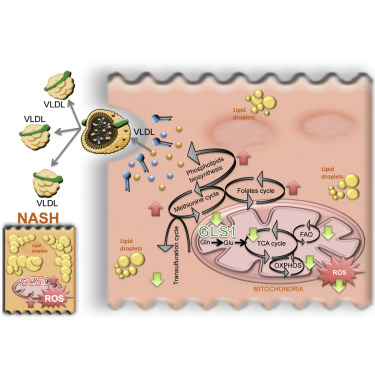当前位置:
X-MOL 学术
›
Cell Metab.
›
论文详情
Our official English website, www.x-mol.net, welcomes your feedback! (Note: you will need to create a separate account there.)
Targeting Hepatic Glutaminase 1 Ameliorates Non-alcoholic Steatohepatitis by Restoring Very-Low-Density Lipoprotein Triglyceride Assembly.
Cell Metabolism ( IF 29.0 ) Pub Date : 2020-02-20 , DOI: 10.1016/j.cmet.2020.01.013 Jorge Simon 1 , Maitane Nuñez-García 2 , Pablo Fernández-Tussy 1 , Lucía Barbier-Torres 1 , David Fernández-Ramos 1 , Beatriz Gómez-Santos 2 , Xabier Buqué 3 , Fernando Lopitz-Otsoa 1 , Naroa Goikoetxea-Usandizaga 1 , Marina Serrano-Macia 1 , Rubén Rodriguez-Agudo 1 , Maider Bizkarguenaga 1 , Imanol Zubiete-Franco 1 , Virginia Gutiérrez-de Juan 1 , Diana Cabrera 4 , Cristina Alonso 5 , Paula Iruzubieta 6 , Manuel Romero-Gomez 7 , Sebastiaan van Liempd 4 , Azucena Castro 5 , Ruben Nogueiras 8 , Marta Varela-Rey 1 , Juan Manuel Falcón-Pérez 9 , Erica Villa 10 , Javier Crespo 6 , Shelly C Lu 11 , Jose M Mato 1 , Patricia Aspichueta 3 , Teresa C Delgado 1 , María Luz Martínez-Chantar 1
Cell Metabolism ( IF 29.0 ) Pub Date : 2020-02-20 , DOI: 10.1016/j.cmet.2020.01.013 Jorge Simon 1 , Maitane Nuñez-García 2 , Pablo Fernández-Tussy 1 , Lucía Barbier-Torres 1 , David Fernández-Ramos 1 , Beatriz Gómez-Santos 2 , Xabier Buqué 3 , Fernando Lopitz-Otsoa 1 , Naroa Goikoetxea-Usandizaga 1 , Marina Serrano-Macia 1 , Rubén Rodriguez-Agudo 1 , Maider Bizkarguenaga 1 , Imanol Zubiete-Franco 1 , Virginia Gutiérrez-de Juan 1 , Diana Cabrera 4 , Cristina Alonso 5 , Paula Iruzubieta 6 , Manuel Romero-Gomez 7 , Sebastiaan van Liempd 4 , Azucena Castro 5 , Ruben Nogueiras 8 , Marta Varela-Rey 1 , Juan Manuel Falcón-Pérez 9 , Erica Villa 10 , Javier Crespo 6 , Shelly C Lu 11 , Jose M Mato 1 , Patricia Aspichueta 3 , Teresa C Delgado 1 , María Luz Martínez-Chantar 1
Affiliation

|
Non-alcoholic steatohepatitis (NASH) is characterized by the accumulation of hepatic fat in an inflammatory/fibrotic background. Herein, we show that the hepatic high-activity glutaminase 1 isoform (GLS1) is overexpressed in NASH. Importantly, GLS1 inhibition reduces lipid content in choline and/or methionine deprivation-induced steatotic mouse primary hepatocytes, in human hepatocyte cell lines, and in NASH mouse livers. We suggest that under these circumstances, defective glutamine fueling of anaplerotic mitochondrial metabolism and concomitant reduction of oxidative stress promotes a reprogramming of serine metabolism, wherein serine is shifted from the generation of the antioxidant glutathione and channeled to provide one-carbon units to regenerate the methionine cycle. The restored methionine cycle can induce phosphatidylcholine synthesis from the phosphatidylethanolamine N-methyltransferase-mediated and CDP-choline pathways as well as by base-exchange reactions between phospholipids, thereby restoring hepatic phosphatidylcholine content and very-low-density lipoprotein export. Overall, we provide evidence that hepatic GLS1 targeting is a valuable therapeutic approach in NASH.
中文翻译:

靶向肝谷氨酰胺酶 1 通过恢复极低密度脂蛋白甘油三酯组装来改善非酒精性脂肪性肝炎。
非酒精性脂肪性肝炎 (NASH) 的特征是炎症/纤维化背景下肝脂肪的积累。在此,我们发现肝脏高活性谷氨酰胺酶 1 亚型 (GLS1) 在 NASH 中过度表达。重要的是,GLS1 抑制可降低胆碱和/或甲硫氨酸剥夺诱导的脂肪变性小鼠原代肝细胞、人类肝细胞系和 NASH 小鼠肝脏中的脂质含量。我们认为,在这些情况下,缺陷性谷氨酰胺为回补线粒体代谢提供能量,同时减少氧化应激,促进丝氨酸代谢的重新编程,其中丝氨酸从抗氧化剂谷胱甘肽的生成中转移,并被引导以提供一碳单位来再生蛋氨酸。循环。恢复的蛋氨酸循环可以诱导磷脂酰乙醇胺N-甲基转移酶介导的和CDP-胆碱途径以及磷脂之间的碱基交换反应合成磷脂酰胆碱,从而恢复肝磷脂酰胆碱含量和极低密度脂蛋白输出。总的来说,我们提供的证据表明肝脏 GLS1 靶向是 NASH 的一种有价值的治疗方法。
更新日期:2020-02-21
中文翻译:

靶向肝谷氨酰胺酶 1 通过恢复极低密度脂蛋白甘油三酯组装来改善非酒精性脂肪性肝炎。
非酒精性脂肪性肝炎 (NASH) 的特征是炎症/纤维化背景下肝脂肪的积累。在此,我们发现肝脏高活性谷氨酰胺酶 1 亚型 (GLS1) 在 NASH 中过度表达。重要的是,GLS1 抑制可降低胆碱和/或甲硫氨酸剥夺诱导的脂肪变性小鼠原代肝细胞、人类肝细胞系和 NASH 小鼠肝脏中的脂质含量。我们认为,在这些情况下,缺陷性谷氨酰胺为回补线粒体代谢提供能量,同时减少氧化应激,促进丝氨酸代谢的重新编程,其中丝氨酸从抗氧化剂谷胱甘肽的生成中转移,并被引导以提供一碳单位来再生蛋氨酸。循环。恢复的蛋氨酸循环可以诱导磷脂酰乙醇胺N-甲基转移酶介导的和CDP-胆碱途径以及磷脂之间的碱基交换反应合成磷脂酰胆碱,从而恢复肝磷脂酰胆碱含量和极低密度脂蛋白输出。总的来说,我们提供的证据表明肝脏 GLS1 靶向是 NASH 的一种有价值的治疗方法。



























 京公网安备 11010802027423号
京公网安备 11010802027423号